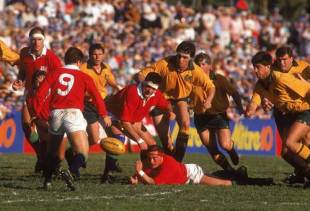|
Australia 12-19 British & Irish Lions, Brisbane
Lions re-find their roar
Richard Seeckts
July 8, 1989

Jeremy Guscott goes over for the British & Irish Lions
© Getty Images Enlarge
After a crushing defeat in the first Test of the 1989 tour, the Lions came back at Australia with a battling, physical performance that shocked the hosts and set up a mouth-watering decider to be played in Sydney a week later. 'The Battle of Ballymore', as Australian newspapers dubbed it, proved to be the turning point of the series. "There can scarcely have been a more ferociously contested encounter in sport, or a victory so richly deserved," wrote Stephen Jones in The Sunday Times. Australia came into this match full of confidence, having dominated every aspect of the first Test and run out comfortable 30-12 winners. Lions coach Ian McGeechan made five changes after the first Test, Scott Hastings, Jeremy Guscott and Rob Andrew coming into the backs, Wade Dooley and Mike Teague joining the forwards. Teague had missed the first Test due to a shoulder injury, Andrew was a late addition to the squad after injury to Ireland's Paul Deans forced him off the tour. The Lions spent much of the game battering Australia into submission, but with only four minutes remaining, they were losing 12-9. Opportunities had been created and squandered, the hard work done for no reward. Frustration was showing as it looked like the series was lost when, after a mighty forward drive down field, captain Finlay Calder hurled a pass to Scott Hastings in midfield. He sent a long, bouncing pass towards brother Gavin on the right, who burst through the remaining defence and scored in front of the Lions' ecstatic supporters. Moments later, scrum half Robert Jones hoisted a kick over a scrum and David Campese, feeling the pressure, dropped it. Calder recovered possession, the ball was laid back to Guscott who chipped ahead, charged through the Wallaby midfield, re-gathered the ball and scored near the posts. This time Andrew converted and with a seven point lead and insufficient time for Australia to score twice, the series was level at 1-1. Though the vital points came late in the match, the Lions had stamped - at times literally - their mark on it from the first minute. As Wallaby captain Nick Farr-Jones fed the first scrum, his opposite number, Robert Jones, trod on his foot, sparking a punch up that set the tone. French referee Rene Hourquet, who didn't speak English, tried to separate the number nines scrapping on the deck while the Lions' forwards piled in on a startled Australian pack. The home team were unsettled, and battle resumed time and again throughout the match, the Lions clearly getting the upper hand. If the violence was not premeditated, Calder's pre-match oration had certainly wound his men up so they were bursting with adrenalin. Jones explained, "Before the match, Finlay emphasised that we were not to take a backward step, that we would tackle hard, put on physical pressure up front, ruck hard and drive the line-out. I knew that if there was any trouble, four men would come instantly to my assistance: Mike Teague, Paul Ackford, Wade Dooley and Dean Richards." Jones identified the first fight as the turning point of the series. "Farr-Jones was distracted from his normal game and was not nearly as effective as he had been the week before."

Lions hooker Brian Moore offloads from the deck
© Getty Images
Enlarge
In between the fights, Australia took the lead though a converted try by full back Greg Martin and a Michael Lynagh penalty. Lynagh's kicking game was far superior to that of Andrew and Hastings, and proved the major factor in keeping Australia in front for so long. Lions prop Dai Young was lucky to stay on the field after an ugly stamping incident in the first half, but he took some punishment instead from Wallaby hooker Tom Lawton. The rough stuff came from both sides, but it was always likely that the team that lost the match would blame their opponents' tactics. Farr-Jones insists: "To say that it wasn't premeditated is absolute nonsense. Robert and I may have instigated it but the Lions forwards piled in straight off. They knew what they were up to and we couldn't match them." Nevertheless, Teague and the rest of the Lions forwards were immensely committed in mind and body, the end justifying the means for them. Teague later explained, "We can't be seen to condone what went on, but needs must. There were some hard players on that tour; hard men and they all came together and sorted the job out." And so they did, albeit late in the day. Calder's verdict on the Australians after the opening skirmish was, "They just looked at us and thought to themselves: 'I don't fancy this lot.'" Some predicted open warfare in the series decider but a great game of rugby broke out, the Lions winning by a point and so becoming the only Lions team to take a series victory having lost the first match. © ESPN Sports Media Ltd.
| |||||||||||||||
Live Sports
Communication error please reload the page.
-
Football
-
Cricket
-
Rugby
-
- Days
- Hrs
- Mins
- Secs
F1 - Abu Dhabi GP
Abu Dhabi Grand Prix December 11-131. Max Verstappen ()
2. Valtteri Bottas (Mercedes)
3. Lewis Hamilton (Mercedes)
4. Alexander Albon ()
5. Lando Norris ()
6. Carlos Sainz Jr ()
-
ESPNOtherLive >>
Golf - Houston Open
Snooker - China Open
Tennis - Miami Open

